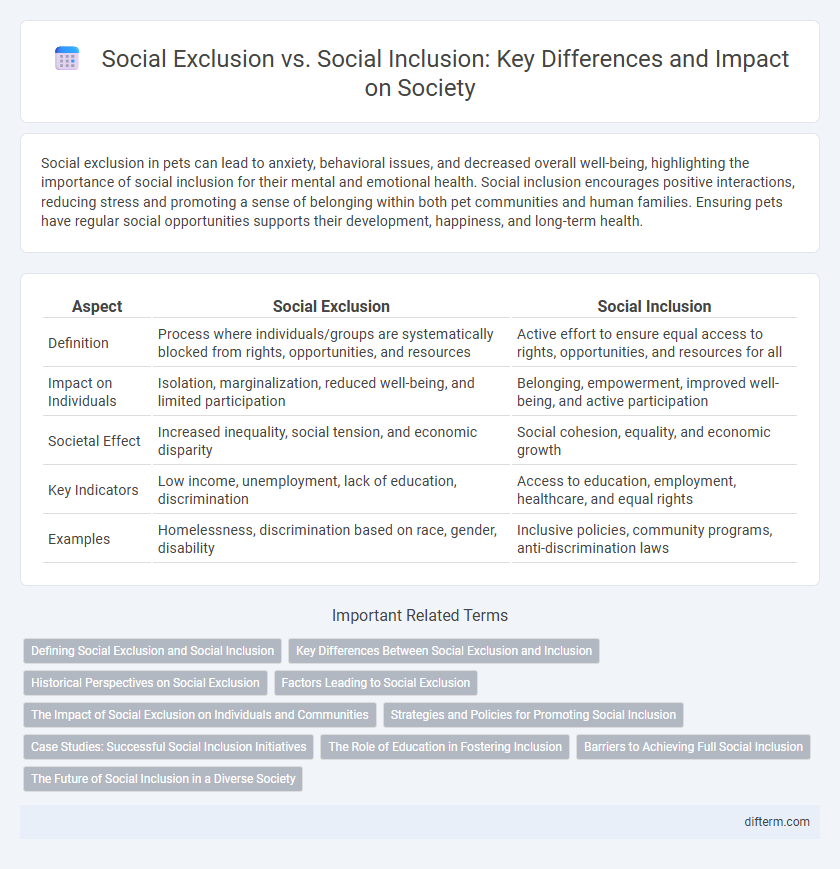Social exclusion in pets can lead to anxiety, behavioral issues, and decreased overall well-being, highlighting the importance of social inclusion for their mental and emotional health. Social inclusion encourages positive interactions, reducing stress and promoting a sense of belonging within both pet communities and human families. Ensuring pets have regular social opportunities supports their development, happiness, and long-term health.
Table of Comparison
| Aspect | Social Exclusion | Social Inclusion |
|---|---|---|
| Definition | Process where individuals/groups are systematically blocked from rights, opportunities, and resources | Active effort to ensure equal access to rights, opportunities, and resources for all |
| Impact on Individuals | Isolation, marginalization, reduced well-being, and limited participation | Belonging, empowerment, improved well-being, and active participation |
| Societal Effect | Increased inequality, social tension, and economic disparity | Social cohesion, equality, and economic growth |
| Key Indicators | Low income, unemployment, lack of education, discrimination | Access to education, employment, healthcare, and equal rights |
| Examples | Homelessness, discrimination based on race, gender, disability | Inclusive policies, community programs, anti-discrimination laws |
Defining Social Exclusion and Social Inclusion
Social exclusion involves the systematic marginalization of individuals or groups from meaningful participation in social, economic, and political activities, leading to inequalities and limited access to resources. Social inclusion promotes equal opportunities, fostering a sense of belonging and active engagement in community life, thereby enhancing social cohesion and individual well-being. Understanding the dynamics between social exclusion and inclusion is essential for developing policies that address disparities and support equitable access to services and opportunities.
Key Differences Between Social Exclusion and Inclusion
Social exclusion refers to the systematic marginalization of individuals or groups from full participation in social, economic, and political life, leading to limited access to resources and opportunities. In contrast, social inclusion emphasizes creating equitable environments where diverse populations can engage fully and benefit from community participation and support systems. Key differences lie in social exclusion's focus on barriers and deprivation, whereas social inclusion promotes integration, empowerment, and equal rights.
Historical Perspectives on Social Exclusion
Historical perspectives on social exclusion reveal patterns of marginalization based on race, class, and gender that shaped societal hierarchies from ancient civilizations to modern times. Colonialism and industrialization institutionalized exclusionary practices, reinforcing systemic inequalities and limiting access to resources for marginalized groups. Social inclusion movements emerged as responses to these historic injustices, advocating for equal rights, recognition, and participation in social, economic, and political spheres.
Factors Leading to Social Exclusion
Factors leading to social exclusion include poverty, discrimination based on race, gender, or disability, and limited access to education and healthcare. Social exclusion is often perpetuated by systemic inequalities and lack of social support networks. These barriers prevent individuals from fully participating in economic, social, and cultural life, reinforcing cycles of marginalization.
The Impact of Social Exclusion on Individuals and Communities
Social exclusion significantly harms individuals by increasing feelings of isolation, lowering self-esteem, and limiting access to essential resources such as education and healthcare. Communities experiencing widespread social exclusion face higher rates of poverty, reduced social cohesion, and increased crime levels. Addressing social exclusion through inclusive policies promotes stronger social networks, economic opportunities, and improved mental health outcomes for all members.
Strategies and Policies for Promoting Social Inclusion
Strategies for promoting social inclusion emphasize equitable access to education, healthcare, and employment, targeting marginalized groups to reduce systemic barriers. Policies often incorporate community participation, anti-discrimination laws, and social protection programs to ensure full societal integration. Data-driven approaches monitor inclusion outcomes, guiding the continuous adaptation of inclusive social frameworks.
Case Studies: Successful Social Inclusion Initiatives
Case studies demonstrate that successful social inclusion initiatives often leverage community engagement, targeted education programs, and access to employment opportunities to reduce social exclusion. For example, the Harlem Children's Zone project in New York City improved educational outcomes and economic prospects by integrating social services with community support. Similarly, the Finnish Basic Income Experiment revealed that providing unconditional financial support enhances social participation and mental well-being among marginalized groups.
The Role of Education in Fostering Inclusion
Education plays a crucial role in fostering social inclusion by promoting equal access to learning opportunities, which helps reduce social exclusion. Inclusive educational practices address diverse needs, support marginalized groups, and encourage a sense of belonging among students from various backgrounds. Schools that prioritize equity and diversity contribute significantly to building cohesive societies with improved social integration and participation.
Barriers to Achieving Full Social Inclusion
Barriers to achieving full social inclusion include systemic discrimination, economic inequality, and limited access to education and healthcare. Social exclusion often stems from prejudices related to race, gender, disability, or socioeconomic status, which restrict opportunities and participation in community life. Effective policies must address these structural obstacles to promote equal access and foster a more inclusive society.
The Future of Social Inclusion in a Diverse Society
The future of social inclusion in a diverse society hinges on implementing equitable policies that address systemic barriers faced by marginalized groups. Integrating technology-driven tools and community-based initiatives fosters meaningful participation and representation across varying cultural, socioeconomic, and ability spectrums. Emphasizing education, accessibility, and empathy promotes resilience against social exclusion while cultivating a cohesive and inclusive social fabric.
social exclusion vs social inclusion Infographic

 difterm.com
difterm.com